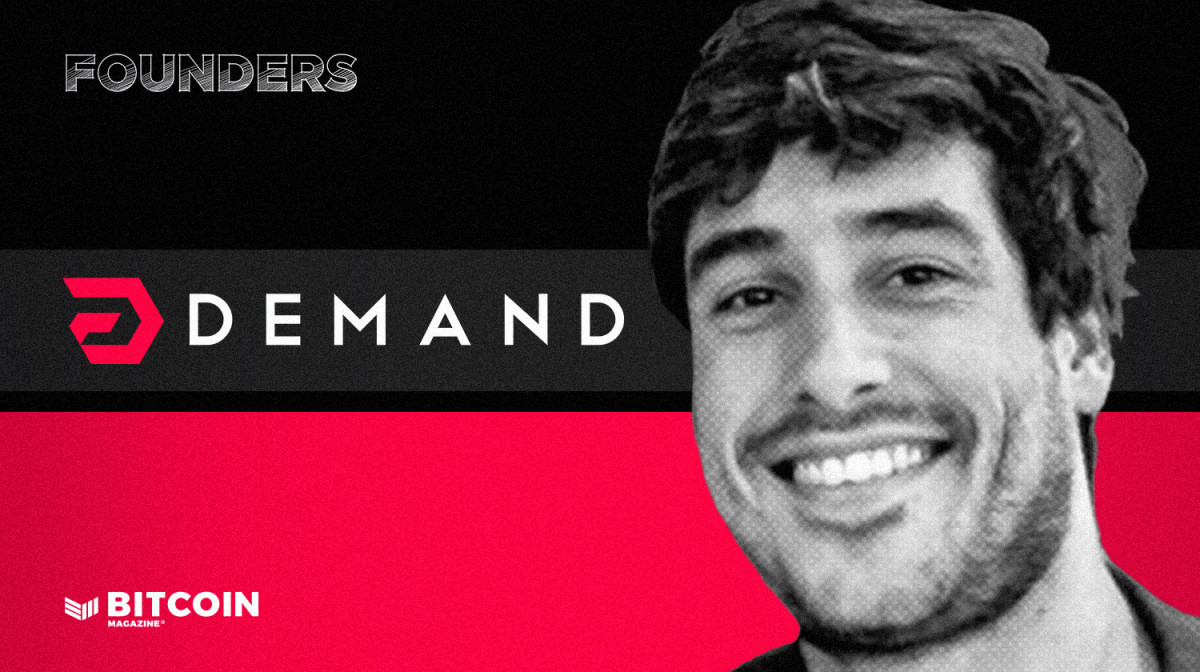Company Name: DEMAND
Founders: Alejandro De La Torre and Filippo Merli
Date Founded: 2023
Location of Headquarters: Lisbon, Portugal and Florence, Italy
Amount of Bitcoin in Treasury: “Currently being bootstrapped”
Number of Employees: 2
Website: https://www.dmnd.work/
Public or Private? Private
Alejandro De La Torre is deeply concerned that Bitcoin mining is too centralized, and he’s on a mission to change that. This is why he started DEMAND, a Bitcoin mining pool that puts power back in the hands of independent Bitcoin miners.
Before getting into how DEMAND works, though, it’s important to understand what De La Torre has learned from his time in the Bitcoin mining industry so as to better understand his motivation in starting DEMAND.
De La Torre’s History In The Bitcoin Mining Space
De La Torre has served as the VP of Poolin, one of the largest Bitcoin and crypto mining pools in the world, as well as the VP of Business Operations for BTC.com, which also operated its own Bitcoin mining pool. What he saw during his time in these two roles made him realize that there was little time to waste in decentralizing the Bitcoin mining landscape.
“The experience I had in the last pools made me realize that we needed a change in the mining pool industry and we needed it very, very quickly,” De La Torre told Bitcoin Magazine. “There’s a very clear problem with centralization in mining pools today, and I was able to pinpoint that issue while working at BTC.com and Poolin.”
De La Torre went on to describe how many Bitcoin mining pools are now proxies for a larger pool, which he didn’t mention by name (it’s Antpool), and explained that such centralization has the power to seriously damage Bitcoin.
“The anchor pool is close to 50% of the network now. It allows for a 51% attack on the network, which would be catastrophic,” said De La Torre.
“I don’t think they would ever do it, but the possibility is there, which is already a huge red flag,” he added.
De La Torre also pointed out that such levels of centralization pose risks when it comes to network censorship, highlighting that it wouldn’t be difficult for this major pool to censor half of the transactions on the Bitcoin network.
The potential for censorship and a 51% attack “are a very clear and present danger that we have in Bitcoin right now,” according to De La Torre.
Power To The Solo Miners
In reaction to this, De La Torre and his business partner, Felippo Merli, launched DEMAND Pool in November 2023 with the intention of putting the power back in the hands of solo miners.
DEMAND is the world’s first Stratum V2 mining pool. Stratum V2 is an open-source messaging protocol that enables miners and pools to communicate directly with each other, reducing mining infrastructure requirements compared to its previous iteration, and enabling solo miners to choose their own mining templates. This latter capability is one of the major features that sets Stratum V2 apart from other mining pool protocols.
“Pools today are the ones who are in charge of building the blocks and adding the transactions into the blocks,” said De La Torre. “With Stratum V2 — with DEMAND — the miners themselves will be able to build the blocks and add the transactions that they want.”
Most filtering in mining pools today is done at the pool level, not the individual miner level. De La Torre understands that especially in the wake of the introductions of protocols like Ordinals and Runes, miners want more control over what types of transactions they include in their blocks. And De La Torre believes miners should have this power, because it adds to the ethos of decentralization.
“This gives me less power. That’s what I want. I don’t want the power. I’m done with that power,” said De La Torre. “I’ve had it before, and it’s too much power in the hands of too few. And that’s not what Bitcoin is. Bitcoin is decentralization, and this is furthering that.”
In efforts to help miners with filtering, DEMAND has created a series of mining templates that miners can readily use in their operations.
Incentivizing Solo Miners
De La Torre is aware that the odds of mining a block are against small-scale solo miners, but he doesn’t think they shouldn’t give finding one a shot, and he’s also created other ways to incentivize solo miners to come online.
“You’ve got to heat up your home during winter, right? Why not just use a Bitcoin miner as a heater?” said De La Torre.
“If you’re lucky, you hit a block and you just made your wife very happy,” he added with a laugh.
Solo miners who join DEMAND Pool will also have the option to sell the hash rate they produce on a marketplace, ensuring that they receive some income for their efforts. DEMAND has set up a deal with the hash rate marketplace Rigly and plans to establish more partnerships.
De La Torre also touched on how DEMAND payments will be done via the PPLNS (Pay Per Last N Share) system. With PPLNS, profits are allocated based on the number blocks a mining pool mines per day and payouts fluctuate based on the pool’s luck in mining blocks.
This system differs from the FPPS (Fee Pay Per Share) system, which is commonly used in the major mining pools. With FPPS, miners charge a service fee based on theoretical profit, and miners get paid whether the pool finds a block or not.
De La Torre is aware that it may sound attractive to miners to get paid consistently with FPPS, but he was quick to point out that payouts through both PPLNS and FPPS are comparable over the long term.
“A lot of people have some misunderstandings about PPLNS,” said De La Torre.
“FPPS gives you constant payouts, which is fine. I understand why a miner would find FPPS. However, PPLNS over enough time averages out to about the same,” he added.
“Yes, you won’t have constant payouts, but you will have incorrect payouts according to how much hash rate DEMAND has — and we intend to have a good amount. You will still be getting a constant payout, or it would average out to more or less the same. So, there’s no real downside to it.”
De La Torre also pointed out that solo mining as part of DEMAND’s pool is one of the best ways for Bitcoin enthusiasts to get their hands on non-KYC bitcoin.
He also stressed the fact that solo miners’ coming online will do something else that’s vital to keeping Bitcoin decentralized — it will bring more nodes online.
Send Nodes
To use DEMAND’s block templates, miners have to run their own nodes. This means that solo miners would not only contribute to the decentralization of Bitcoin’s hash rate but also to the decentralization of its governance.
“Not only do we want the solo community and the home mining community to flourish and to make more money, but we also want node proliferation,” said De La Torre.
“Solo miners will provide hash rate to secure the network and potentially make some bitcoin and also help with maintaining Bitcoin Core or whatever Bitcoin client they want. Nodes are good for the health of the system,” he added.
Looking Ahead
De La Torre also said that DEMAND is currently working on expanding its services to pooled mining, and that DEMAND will actively be looking for miners to come on board.
He’s vowed to make DEMAND a “stable and trustworthy pool with transparent payouts,” differentiating it from the “black box” pools out there.
De La Torre seems to be doing everything in his power to bring more independent miners online, and as he laid out his plans for DEMAND in my conversation with him, there was a palpable sense of urgency in his voice.
“The centralization of Bitcoin mining pools is becoming a very serious issue, and it’s up to us as the mining community to do something about it,” said De La Torre. “If we don’t, it’s not good.”





